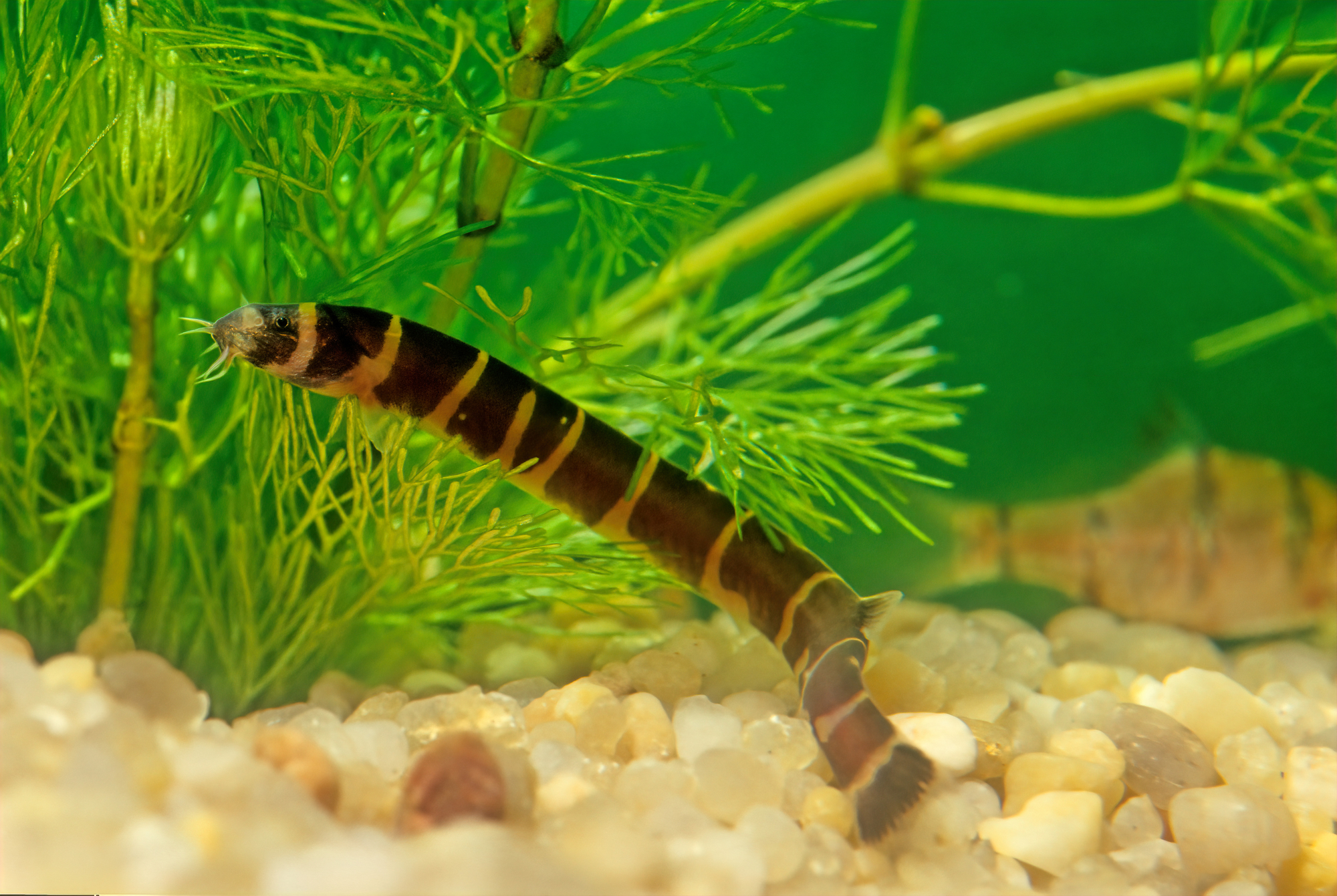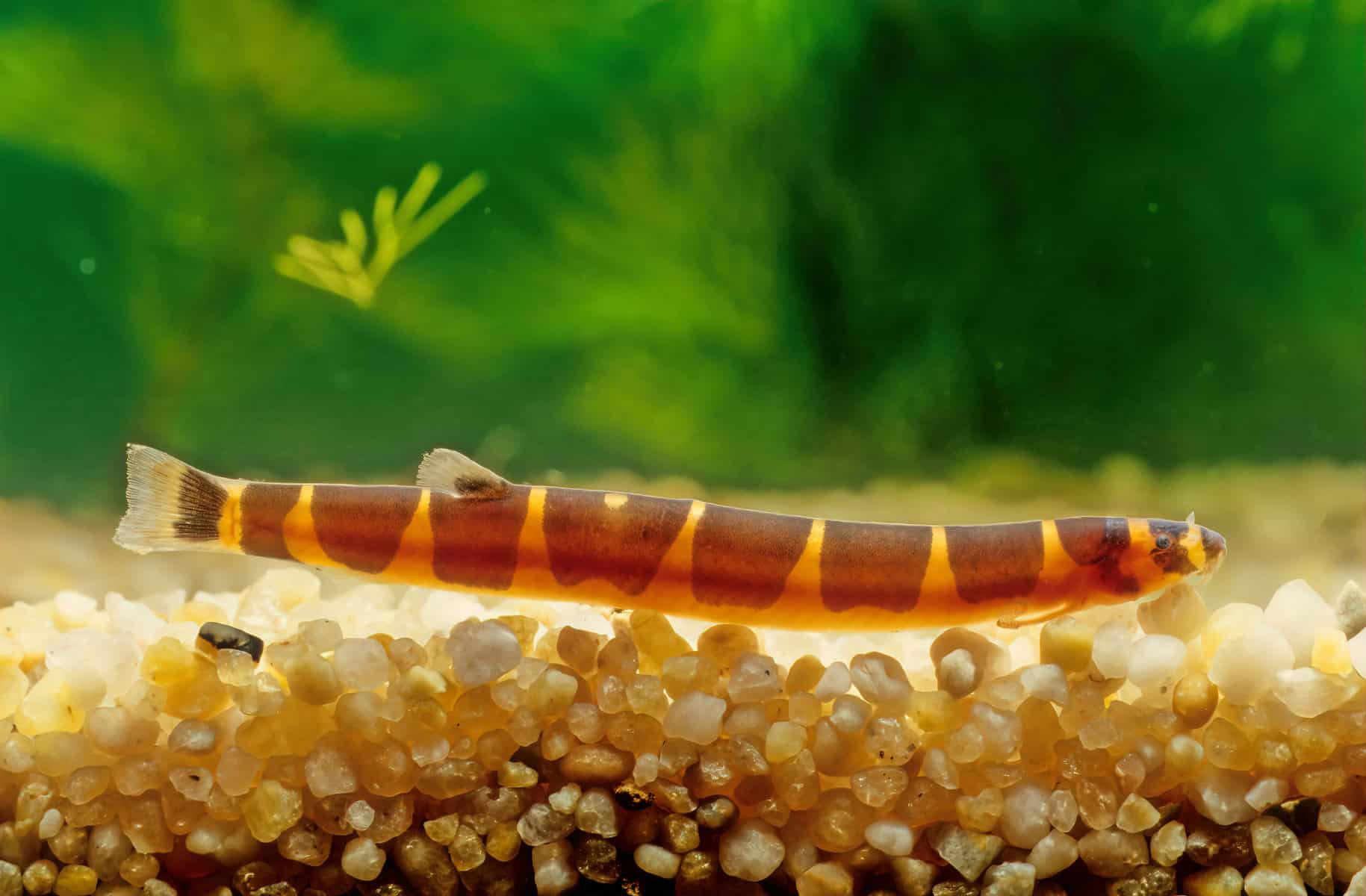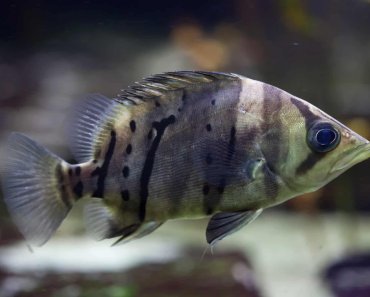Kuhli loaches are one of my favorite fish. Mysterious, nocturnal, and eel-like, these beautiful creatures make a fascinating addition to most community tank setups.
Some fishkeepers, however, are concerned about keeping kuhli loaches with shrimp. After all, other loach species are notorious for eating invertebrates, and there have been rumors on the internet about kuhlis eating pet shrimp.
Here I’ll try to untangle the facts from the fiction, starting with the first surprising question: ‘What exactly is a kuhli loach?!’ It’s not what you think…
The Truth About Kuhli Loaches
Kuhli loaches are a popular, yet mysterious fish in the aquarium hobby, and many myths surround this adorable oddball fish!
The first shocking fact is that true kuhli loaches (Pangio kuhlii) are either extremely rare or non-existent in the aquarium trade! The original kuhli loach was originally described as Cobitis kuhlii by Achille Valenciennes in 1846, but this species is endemic only to the island of Java of Indonesia, where wild fish are rarely caught for the aquarium trade.
The species of loach that is usually marketed as the kuhli loach is actually Pangio semicincta or the ‘half-banded kuhli loach’. A close cousin of the true kuhli, this fish looks similar but is native to the Malay Peninsula, Borneo, and Sumatra, rather than Java.
There may also be other Pangio loach species that have entered the pet trade under the name ‘kuhli loach’, and each one of them is bound to have slightly different dietary habits.
But since it’s the most common type, I’ll focus mainly on the half-banded kuhli loach here.
Quick Profile of the Half-Banded Kuhli Loach
| Half-Banded Kuhli Loach Info | |
|---|---|
| Scientific Name | Pangio semicinta |
| Adult Size | 4 inches (12 cm) |
| Lifespan | 10 years + |
| Minimum Tank Size | 15 gallon |
| pH | 6.0–6.5 |
| Hardness | 1–10 dGH |
| Temperature | 75–86 °F(24-30 °C) |
| Tankmates | Other peaceful fish |
Overview

The half-banded kuhli is a peaceful fish that makes an ideal member of most community tanks. They are mostly nocturnal and their main requirement is plenty of caves and places to hide during the day.
They’re also social fish that need to be kept in groups of 5 or more to be truly happy. They prefer soft, acidic water, so adding driftwood or Indian Almond Leaves may help to get water parameters right for them.
Half Banded Kuhli Loach Diet
Kuhli loaches are opportunistic and omnivorous fish that typically dwell and feed at the bottom of the aquarium. They make a useful addition to an aquarium’s ‘clean up crew’ since they’ll often eat bits of food that have fallen to the bottom of the tank that would rot and contaminate the fish tank water if left uneaten.
In the wild, these tropical fish will forage in the substrate for various insects and invertebrates to eat. In an aquarium, they will relish the chance to feed on live and frozen types of food such as bloodworms, tubifex worms, daphnia, mosquito larvae, brine shrimp, and mysis shrimp.
Kuhli Loaches, Brine Shrimp, and Mysis Shrimp
Kuhli loaches will definitely enjoy eating either live or frozen brine shrimp and mysis shrimp, but while both of these species are crustaceans like pet shrimps are, they are quite different and a lot smaller than true shrimps.
Brine shrimp grow to a maximum of 0.4 inches, and most mysis shrimp are also around this size when fed to fish.
Kuhli Loaches and Pet Shrimps
There’s a lot of controversy about whether kuhli loaches will eat pet shrimp species.
The most popular types of freshwater aquarium shrimps are ghost shrimps, cherry shrimps, and Amano shrimps. These shrimps (especially Amano) are fantastic for eating algae, and so are becoming increasingly popular for peaceful community tanks.
Ghost shrimp and cherry shrimp typically grow to around 1.5 inches long at adulthood, whereas Amano shrimp are slightly larger at about 2 inches in size. All of them are a lot larger than the brine shrimp and mysis shrimp typically fed to aquarium fish.
Since kuhli loaches only grow to 4 inches long, a 1.5-inch long shrimp would seem to be quite a large meal for them.
The Stories of Kuhli Loaches Eating Snails
Online aquarium forums are full of mixed reports about how compatible kuhli loaches are with pet shrimps. While some fish keepers report keeping these two animals together for years without problems, others have found that their shrimps seem to go missing after introducing kuhli loaches.
It’s difficult to get to the bottom of this since kuhli loaches are incredibly secretive creatures and usually come out at night when we’re not looking. Shrimp are also short-lived and are renowned for dying when water conditions are not ideal for them. The kuhlis may not have been to blame.
Different Kuhli Loaches, Different Diet
Each fish also has its own personality, and while some kuhli loaches may never show any interest in eating pet shrimp, it’s possible that others would, especially if they’re hungry!
What further complicates the matter is the different species of kuhli loaches which are bound to have different feeding habits.
As I described at the beginning, the kuhli loach family is quite large, and although the vast majority of them sold in pet stores are likely to be half-banded kuhlis, there are some other species that could also occasionally enter the mix.
With this genetic diversity, it’s difficult to make any guarantees about what ‘kuhlis’ would or wouldn’t eat.
Is It Safe To Keep Kuhli Loaches With Cherry Shrimps and Ghost Shrimps?
Having read through lots of first-hand experiences from fish keepers keeping these two species together, my conclusion is that adult cherry shrimps and ghost shrimps are safe to keep with kuhli loaches in most situations.
Although some aquarists have reported problems, the majority of the time, the two should live together amicably.
To increase the likelihood of keeping these species together successfully, check out my tips at the end of the article!
Can Kuhli Loaches Live With Amano Shrimp?
Since Amano shrimp grow larger than cherry or ghost shrimp, it seems even more unlikely that they’d become lunch for your kuhli. Reports from online communities seem to confirm this logic, and I’ve yet to come across anyone who suspected their kuhli loach eating their Amano shrimp!
Which Shrimp Are Safe To Keep With Kuhli Loaches?
As I mentioned, Amano shrimp are probably quite safe to keep with kuhli loaches. Other larger shrimps include bamboo shrimp and vampire shrimp, both of which can grow to at least 3 inches. Almost as large as a kuhli, they should make fine tank mates!
Will Kuhli Loaches Eat Shrimplets?
Although it’s unlikely that kuhli loaches would attack a fully grown pet shrimp, there’s no doubt that they eat their babies! Amano shrimp seldom breed in captivity, but cherry shrimp and ghost shrimp are quite the opposite and can spawn prolifically!
It’s not only kuhli loaches that will eat aquarium shrimplets though. Baby shrimp present a highly nutritious type of food for most community tank fish, meaning that even tiny fish like neon tetras will eat their share too!
Having some efficient baby shrimp eaters in a shrimp tank is not necessarily a bad idea, since shrimp can breed very rampantly and easily overpopulate an aquarium.
Do Kuhli Loaches Eat Aquarium Snails?

Sometimes, yes! While it’s unlikely that your kuhli loaches will eat large, fully grown snails, they are well-documented for eating baby snails, as well as smaller snail species. If you have a problem with your aquarium snails overbreeding, a school of kuhli loaches might help you out.
There are even better fish for controlling aquatic snail populations, though, so be sure to check out my list of 22 snail-eating fish if you’re looking for a solution to your snail problem!
Keeping Kuhli Loaches and Shrimp Together Peacefully
It seems that the majority of the time, kuhli loaches and shrimp can live amicably together. But for this mix to work out, you still need the right kind of tank setup.
Some aquarists have reported their kuhli loaches chasing their shrimps around when there were few hiding places in the tank. This makes a lot of sense since both kuhli loaches and shrimps need lots of hiding places to feel safe and secure.
If they are constantly exposed, both animals will become stressed, leading to agitation, aggression, and even predation. The best thing you can do to keep these two living together peacefully is to offer plenty of live plants and caves for them to hide in, and provide them with a large enough tank.
A school of 5 kuhli loaches with a similar number of shrimp will need at least a 30-gallon aquarium to live together in harmony.
In addition to these tips, keep your kuhli loach well-fed so that they’re not forced to look for alternative sources of food! They do well on food that quickly sinks to the bottom of the tank, such as algae wafers and frozen foods.
Conclusion
Having researched the topic thoroughly, my conclusion is that it’s unlikely that your kuhli loach would eat fully-grown aquarium shrimp.
While smaller species like cherry shrimp and ghost shrimp might, on rare occasions, become a target for a very hungry kuhli, larger shrimp species should be entirely off the menu.
To find out more about different shrimp species you can keep in freshwater aquariums, check out our dedicated guide here.


























